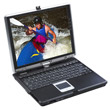Over the past several years, due to the never-ending advances in
technology, laptops have become powerful enough and also inexpensive
enough that many people are now considering purchasing one as a
secondary computer or even as a primary computer. While this has given
manufacturers a whole new group of end-users to consider, they still
haven't forgotten the needs of the business user.
 Whereas a home user may want to play games, watch movies or use a computer as an all-around entertainment system, for a business user, these functions are more of a diversion and are not a primary requirement in a computer. The business user might prefer a lightweight yet powerful system that is rugged enough to take the beating of being constantly transported from place to place. Whereas a home user may want to play games, watch movies or use a computer as an all-around entertainment system, for a business user, these functions are more of a diversion and are not a primary requirement in a computer. The business user might prefer a lightweight yet powerful system that is rugged enough to take the beating of being constantly transported from place to place.
Form Factor
In terms of size, most business users prefer a machine that is somewhere between a desktop replacement and an ultralight laptop. These types of laptops are commonly referred to as "two-spindled" machines. What this means is that there are only two drives present: a hard drive and a CD or DVD drive. Desktop replacements are usually three-spindled machines, adding a floppy or another CD/DVD drive to the other two. Ultralights are one-spindled machines with only a hard drive. For storage options and weight, two-spindled machines offer a nice compromise between desktop replacements and ultralight laptops.
A key feature to look for in a business laptop is a swappable drive bay. Instead of having a fixed CD/DVD drive always installed in the computer, this drive can be removed and fitted with different devices. Having a swap bay allows you a wider range of options, and the system can be further customized to fit your needs, even if your needs vary from day to day. If you find yourself on a long road trip away from a power outlet, a second battery can be installed in the drive bay. If more storage is needed or if you wish to back up your entire system, insert a second hard drive into the bay. Other possible devices that can be used in the bay include a numeric keypad for those who frequently work with numbers, or even a dock for a PDA. You can even lighten your load by placing an empty shell in the drive bay. Note that not all manufacturers offer these optional swap bay devices for their laptops, so it's a good idea to check to see what options are available if you have a specific requirement.
Business laptops often have an extra port that allows the system to be attached to a docking station or port replicator. Instead of getting to your office and having to plug in cables for an external monitor, keyboard or mouse, then having to network one by one, all of these external devices can be permanently attached to the dock so that all you have to do is slide your laptop into the dock in one easy step. A port replicator does what its name suggest - it duplicates ports that are already on the laptop and doesn't add any extra functions. On the other hand, a docking station duplicates all the ports and it allows for extra drives or expansion cards to be added. A docking station can turn a portable laptop into a full-fledged desktop system.
If you frequently have to enter user IDs and passwords in order to access a multitude of networks or protected data, you may want to look for a laptop that has an integrated fingerprint reader. Instead of manually typing in the ID/password every time, this system can be programmed to enter your log-in automatically when you swipe your finger over the reader.
Processor
Laptops with the Intel® Centrino™ designation generally feature a Pentium® M processor, an Intel chipset and an Intel PRO/Wireless Network Card. These three components all work together to help you get the most of your battery life in a wireless networking environment.
Today's "Sonoma" Centrino Mobile Technology laptops are virtually as powerful as Pentium 4 laptops. There are some tasks that the P4 excelled at but the power/battery trade-off is far more important to the business user. This new version of Centrino featuring the new Intel 915 Express chipset, boasts several improvements. An increased bus speed from 400MHz to 533MHz gives the entire system a speed boost. As well, DDR2 RAM is now supported, yielding an increase of speed (up to 3 times faster memory access speed) while using 33% less power.
Intelligent circuitry built in to a Pentium M chip automatically decreases its clock speed when less processing power is required. As a result, there's less drain on your battery, allowing you to work longer on a single charge. In addition, more cache RAM included with the chip allows the processor to work more efficiently, meaning that certain tasks can be done more quickly, which again means power savings.
On the wireless front, new dual-band Wi-Fi® cards now work with 802.11a, in addition to 802.11b/g, allowing you the ability to roam in virtually any wireless hot spot. Also included are several other new features, such as support for the new PCI Express graphics, the smaller form factor of Expresscards, as well as for serial ATA (SATA) hard drives. All this adds up to better performance while at the same time maximizing battery life and minimizing weight.
|